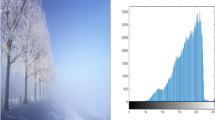Abstract
Image contrast enhancement is frequently referred to as one of the most important issues in image processing because it is a necessary pre-processing step in many computer vision and image processing algorithms. Contrast enhancement is normally required to increase the quality of low contrast images by expanding the dynamic range of input gray level. However, image contrast enhancement without disturbing other parameters of the image is one of the difficult tasks in image processing. To efficiently enhance images, algorithms based on multi-scale top-hat morphological transform (MSTH) have been proposed. However, scale selection to stop the algorithm is very subjective and empirical. In order to automatically select the iterations number required by MSTH algorithm, an automatic stopping criterion based on the contrast improvement ratio revisited is proposed in this paper.







Similar content being viewed by others
References
Bai, X., & Zhou, F. (2010). Multi Scale Top-hat Transform Based Algorithm for Image Enhancement. In ICSP2010 Proceedings, pp. 797–800.
Bai, X., Li, Y., & Zhou, F. (2012). Measure of image clarity using image features extracted by the multiscale top-hat transform. Journal of Optics, 14(4), 045402.
Bai, X., & Zhou, F. (2013). A unified form of multi-scale top-hat transform based algorithms for image processing. Optik (Stuttg), 124(13), 1614–1619.
Canny, J. (1986). A computational approach to edge detection. IEEE Transactions on Pattern Analysis and Machine Intelligence, PAMI–8(6), 679–698.
Firoz, R., Ali, M. Shahjahan, Khan, M. Nasir Uddin, Hossain, M. Khalid, Islam, M. Khairul, & Shahinuzzaman, M. (2016). Medical image enhancement using morphological transformation. Journal of Data Analysis and Information Processing, 4(4), 1–12.
Hassanpour, H., Samadiani, N., & Salehi, S. M. Mahdi. (2015). Using morphological transforms to enhance the contrast of medical images. The Egyptian Journal of Radiology and Nuclear Medicine, 46(2), 481–489.
Jagannath, H. S., Virmani, J., & Kumar, V. (2012). Morphological enhancement of microcalcifications in digital mammograms. Journal of The Institution of Engineers (India): Series B, 93(3), 163–172.
João, A., Gambaruto, A. M., Tiago, J., & Sequeira, A. (2016). Computational advances applied to medical image processing: an update. Open Access Bioinformatics, 8, 1–15.
Kamra, A., Jain, V. K., & Pragya, (2015). Contrast enhancement of masses in mammograms using multiscale morphology. International Journal of Medical, Health, Biomedical, Bioengineering and Pharmaceutical Engineering, 9(7), 546–549.
Kimori, Y. (2013). Morphological image processing for quantitative shape analysis of biomedical structures: Effective contrast enhancement. Journal of Synchrotron Radiation, 20(6), 848–853.
Le, T. K. (2013). Segmentation of lung vessels together with nodules in CT images using morphological operations and level set. Journal of Medical and Bioengineering, 2(1), 5–10.
Maragatham, G., & Roomi, M. (2015). A Review of Image Contrast Enhancement Methods and Techniques. Research Journal of Applied Sciences, Engineering and Technology, 9(5), 309–326.
Maragos, P. (2005). Morphological Filtering for image enhancement and feature detection. In The image and video processing handbook (2nd ed.), 2nd ed., A. C. Bovik, Ed. Elsevier Academic Press, pp. 135–156.
Mukhopadhyay, S., & Chanda, B. (2000). Local contrast enhancement of grayscale images using multiscale morphology. In ICVGIP, pp. 1–8.
Pesaresi, M., & Benediktsson, J. A. (2001). A new approach for the morphological segmentation of high-resolution satellite imagery. IEEE Transactions on Geoscience and Remote Sensing, 39(2), 309–320.
Renieblas, G. Prieto, Nogués, A. Turrero, González, A. Muñoz, Gómez-Leon, N., & del Castillo, E. Guibelalde. (2017). Structural similarity index family for image quality assessment in radiological images. Journal of Medical Imaging, 4(3), 1–11.
Ritika, (2012). A novel approach for local contrast enhancement of medical images using mathematical morphology. International Journal of Computer Science, Information Technology, and Security, 2(2), 392–397.
Serra, J. P. (1982). Image analysis and mathematical morphology (2nd ed., Vol. 1). New York: Academic Press.
Serra, J. P., & Soille, P. (1994). Mathematical morphology and its applications to image processing (Vol. 2). Berlin: Springer Science and Business Media.
Serra, J. P. (2006). A lattice approach to image segmentation. Journal of Mathematical Imaging and Vision, 24(1), 83–130.
Shannon, C. E. (1948). A mathematical theory of communication. Bell System Technical Journal, 27(379–423), 623–656.
Soille, P. (2004). Morphological image analysis: Principles and applications, Second. Berlin: Springer.
Wang, Y.-P., Wu, Q., Castleman, K. R., & Xiong, Z. (2003). Chromosome image enhancement using multiscale differential operators. IEEE Transactions on Medical Imaging, 22(5), 685–693.
Zadorozny, A., & Zhang, H. (2009). Contrast enhancement using morphological scale space. In IEEE international conference on automation and logistics, pp. 804–807.
Author information
Authors and Affiliations
Corresponding author
Additional information
Publisher's Note
Springer Nature remains neutral with regard to jurisdictional claims in published maps and institutional affiliations.
Rights and permissions
About this article
Cite this article
Bustacara-Medina, C., Flórez-Valencia, L. An Automatic Stopping Criterion for Contrast Enhancement Using Multi-scale Top-Hat Transformation. Sens Imaging 20, 26 (2019). https://doi.org/10.1007/s11220-019-0239-x
Received:
Revised:
Published:
DOI: https://doi.org/10.1007/s11220-019-0239-x




